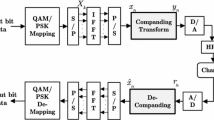Abstract
Orthogonal frequency division multiplexing (OFDM) technology promises to be a key technique for achieving high data rates in the present as well as future broadband wireless communication systems. In spite of several advantages, one of the major drawbacks of OFDM system is its high peak to average power ratio (PAPR), which degrades the overall performance and results in many restrictions for practical applications. To reduce the PAPR, a novel PAPR reduction technique is proposed here that provides optimum bit error rate (BER) performance, better design flexibility and more degrees of freedom compared to other existing companding schemes. In this proposed technique, original distribution function of OFDM signal magnitude is transformed into a triangular distribution function for achieving a favorable trade-off between PAPR reduction and BER performance. A theoretical performance study with general formulas of the proposed scheme is presented and a comparative analysis is done with the existing algorithms. Extensive simulation results demonstrate that our proposed scheme can substantially outperform the existing non-linear companding transform (NCT) techniques in terms of PAPR reduction, BER and power spectrum density (PSD) performance.









Similar content being viewed by others
References
Aliasgari M, Abbasfar A, Fakhraie SM (2013) Coding techniques to mitigate out-of-band radiation in high data rate OFDM-based cognitive radios. Comput Electr Eng 39:373–385. doi:10.1016/j.compeleceng.2012.10.010 (Elsevier Ltd.)
Behravan A, Eriksson T (2009) Tone reservation to reduce the envelope fluctuations of multicarrier signals. IEEE Trans Wireless Commun 8(5):2417–2423
Choe KD, Kim SC, Park SK (2004) Pre-scrambling method for PAPR reduction in OFDM communication systems. IEEE Trans Consumer Electron 50(4):1044–1048
Digital Video Broadcasting (DVB); Framing structure, channel coding and modulation for digital terrestrial television, ETSI EN 300 744 V1.1.2 (1997–08). European Telecommunications Standards Institute, pp 9–26
Dursun S, Grigoryan AM (2010) Nonlinear L2-by-3 transform for PAPR reduction in OFDM systems”. Comp Electr Eng 36:1055–1065. doi:10.1016/j.compeleceng.2010.03.008 (Elsevier Ltd.)
Elavarasan P, Nagarajan G (2015) Peak-power reduction using improved partial transmit sequence in orthogonal frequency division multiplexing systems. Comput Electr Eng 44:80–90. doi:10.1016/j.compeleceng.2015.01.010 (Elsevier Ltd.)
Han SH, Lee JH (2005) An overview of peak-to-average power ratio reduction techniques for multicarrier transmission. IEEE Trans Wireless Commun 12(2):56–65
Hou J, Ge J, Zhai D, Li J (2010) Peak-to-average power ratio reductionof OFDM signals with nonlinear companding scheme. IEEE Trans Broadcast 56(2):258–262
Hu M, Li Y, Wang W, Zhang H (2014) A piecewise linear companding transform for PAPR reduction of OFDM signals with companding distortion mitigation. IEEE Trans Broadcast 60(3):532–539
Hung Ho-Lung (2011) Using evolutionary computation technique for tradeoff between performance peak-to average power ration reduction and computational complexity in OFDM systems. Comput Electr Eng 37:57–70. doi:10.1016/j.compeleceng.2010.08.002 (Elsevier Ltd.)
Hwang T, Yang C, Wu G, Li S, Lee GY (2009) OFDM and its wireless application: a survey. IEEE Trans Veh Technol 58(4):1673–1694
Jaing T, Xiang W, Richardson PC, Qu D, Zhu G (2007) On the nonlinear companding transform for reduction in PAPR of MCM. IEEE Trans Wireless Commun 6(6):2017–2021
Jeng SS, Chen JM (2011) Efficient PAPR reduction in OFDM systems based on a companding technique with trapezium distribution. IEEE Trans Broadcast 57(2):291–298
Jiang T, Wu Y (2008) An overview: peak-to-average power ratio reduction techniques for OFDM signals. IEEE Trans Broadcast 54(2):257–268
Jiang T, Yang Y, Song Y (2005) Exponential companding transform for PAPR reduction in OFDM systems. IEEE Trans Broadcast 51(2):244–248
Jie Y, Lei C, Quan L, De C (2007) A modified selected mapping technique to reduce the peak-to-average power ratio of OFDM signals. IEEE Trans Consumer Electron 53(3):846–851
Kotz S, van Dorp JR (2004) The Triangular Distribution. Beyond beta: other continuous families of distributions with bounded support and applications, vol 1. World Scientific, pp 1–32. ISBN: 978-981-256-115-2
Krongold BS, Jones DL (2003) PAR reduction in OFDM via active constellation extension. IEEE Trans Broadcast 49(3):258–268
Liu Miao, Wang Ke, Huang Yue, Li Xiangling (2011) Reducing PAPR byselecting optimal wavelet tree structure in WOFDM. Comput Electr Eng 37:253–260. doi:10.1016/j.compeleceng.2010.12.003 (Elsevier Ltd.)
van Nee R, Prasad R (2000) OFDM for wireless multimedia communications. Artech House, Boston
Varahram P, Al-Azzo WF, Ali BM (2010) A low complexity partial transmit sequence scheme by use of dummy signals for PAPR reduction in OFDM systems. IEEE Trans Consumer Electron 56(4):2416–2420
Wang Y, Ge JH (2012) Nonlinear Companding Transform Technique for Reducing PAPR of OFDM Signals. IEEE Trans on Consumer Electron 58(3):752–757
Wang Y-C, Luo Z-Q (2011) Optimized iterative clipping and filtering for PAPR reduction of OFDM signals. IEEE Trans Commun 59(1):33–37
Wang L, Tellambura C (2005) A simplified clipping and filtering technique for PAR reduction in OFDM Systems. IEEE Signal Process Lett 12(6):453–456
Wang XB, Tjhung TT, Ng CS (1999) Reduction of peak-to-average power ratio of OFDM system using a companding technique. IEEE Trans Broadcast 45(3):303–307
Wang Y, Wang L-H, Ge J-H, Ai B (2012) An efficient nonlinear companding transform for reducing PAPR of OFDM signals. IEEE Trans Broadcast 58(4):677–684
Wang Y, Ge J, Wang L, Li J, Ai B (2013) Nonlinear companding transform for reduction of peak-to-average power ratio in OFDM systems. IEEE Trans Broadcast 59(2):369–375
Wang Y, Yang C, Ai B (2015) Iterative companding transform and filtering for reducing PAPR of OFDM signal. IEEE Trans Consumer Electron 61(2):144–150
Yang P, Hu A (2011) Two-piecewise companding transform for PAPR reduction of OFDM signals. In: proceedings of wireless communications and mobile computing conference (IWCMC), Istanbul, Turke, pp 619–623
Author information
Authors and Affiliations
Corresponding author
Appendix
Appendix
To calculate inverse cumulative distribution function from (8)
Further, from Eq. (8) we get
The expanding function C −1TR (r n ) of our proposed scheme can be obtained using Eq. (12)
Further using Eq. (12) we obtain
Rights and permissions
About this article
Cite this article
Bhattacharjee, S., Rakshit, M., Sil, S. et al. Triangular Distribution-Based Companding Technique for Reducing PAPR of OFDM Systems. Iran J Sci Technol Trans Electr Eng 41, 175–186 (2017). https://doi.org/10.1007/s40998-017-0030-8
Received:
Accepted:
Published:
Issue Date:
DOI: https://doi.org/10.1007/s40998-017-0030-8




